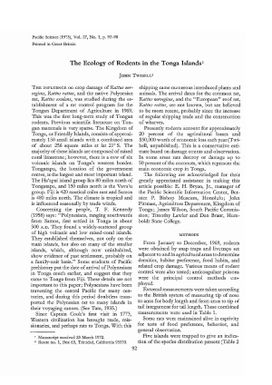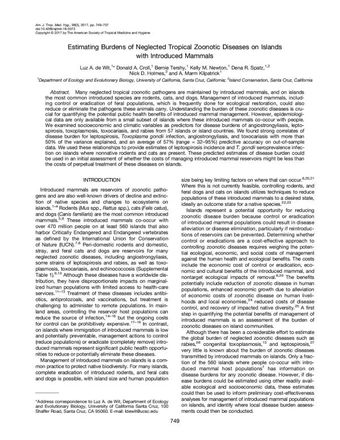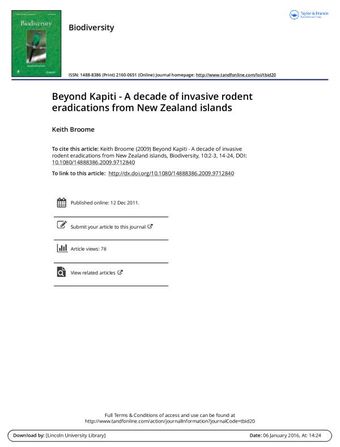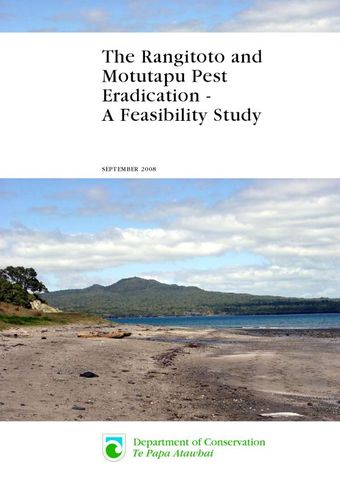The Ecology of Rodents in the Tonga Islands
- Description:
- The influence on crop damage of Rattus norvegicus, Rattus rattus, and the native Polynesian rat, Rattus exulans, was studied during the establishment of a rat control program for the Tongan Department of Agriculture in 1969. This was the first long-term study of Tongan rodents. Previous scientific literature on Tongan mammals is very sparse. The Kingdom of Tonga, or Friendly Islands, consists of approximately 150 small islands with a combined area of about 256 square miles at lat 21 0 S. The majority of these islands are composed of raised coral limestone ; however, there is a row of six volcanic islands on Tonga's western border. Tongatapu, the location of the government center, is the largest and most important island. The Ha'apai island group lies 80 miles north of Tongatapu, and 150 miles north is the Vava'u group. Fiji is 420 nautical miles east and Samoa is 480 miles north. The climate is tropical and is influenced seasonally by trade winds. Since Captain Cook's first visit in 1773, Western civilization has brought trade, missionaries, and perhaps rats to Tonga. With this shipping came numerous introduced plants and animals. The arrival dates for the common rat, Rattus norvegicus, and the "European" roof rat, Rattus rattus, are not known, but are believed to be more recent, probably since the increase of regular shipping trade and the construction of wharves. Presently rodents account for approximately 20 percent of the agricultural losses and $50,000 worth of economic loss each year (Twibell, unpublished). This is a conservative estimate based on damage counts and observation. In some areas rats destroy or damage up to 50 percent of the coconuts, which represent the main economic crop in Tonga. THE INFLUENCE on crop damage of Rattus norvegicus, Rattus rattus, and the native Polynesian rat, Rattus exulans, was studied during the establishment of a rat control program for the Tongan Department of Agriculture in 1969. This was the first long-term study of Tongan rodents. Previous scientific literature on Tongan mammals is very sparse. The Kingdom of Tonga, or Friendly Islands, consists of approximately 150 small islands with a combined area of about 256 square miles at lat 21 0 S. The majority of these islands are composed of raised coral limestone ; however, there is a row of six volcanic islands on Tonga's western border. Tongatapu, the location of the government center, is the largest and most important island. The Ha'apai island group lies 80 miles north of Tongatapu, and 150 miles north is the Vava'u group. Fiji is 420 nautical miles east and Samoa is 480 miles north. The climate is tropical and is influenced seasonally by trade winds. Since Captain Cook's first visit in 1773, Western civilization has brought trade, missionaries, and perhaps rats to Tonga. With this shipping came numerous introduced plants and animals. The arrival dates for the common rat, Rattus norvegicus, and the "European" roof rat, Rattus rattus, are not known, but are believed to be more recent, probably since the increase of regular shipping trade and the construction of wharves. Presently rodents account for approximately 20 percent of the agricultural losses and $50,000 worth of economic loss each year (Twibell, unpublished). This is a conservative estimate based on damage counts and observation. In some areas rats destroy or damage up to 50 percent of the coconuts, which represent the main economic crop in Tonga.
- Collections:
- Secretariat of the Pacific Regional Environment Programme (SPREP)
- Content partner:
- Secretariat of the Pacific Regional Environment Programme (SPREP)
- Availability:
- Not specified
-
Copyright status: All rights reservedFind out more about what you are able to do with this itemThis item is all rights reserved, with means you'll have to get permission from Secretariat of the Pacific Regional Environment Programme (SPREP) before using it. For more information, please see our use and reuse page.What can I do with this item?Non-infringing useNZ copyright law does not prevent every use of a copyright work, and this item may be hosted by an international institute or organisation. You should consider what you can and cannot do with a copyright work.No sharingYou may not copy and/or share this item with others without further permission. This includes posting it on your blog, using it in a presentation, or any other public use.No modifyingYou are not allowed to adapt or remix this item into any other works.No commercial useYou may not use this item commercially.
Related items
Welcome and warm Pasifik greetings
The information on this site has been gathered from our content partners.
The names, terms, and labels that we present on the site may contain images or voices of deceased persons and may also reflect the bias, norms, and perspective of the period of time in which they were created. We accept that these may not be appropriate today.
If you have any concerns or questions about an item, please contact us.



